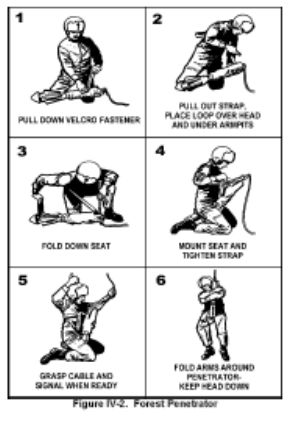SURVIVAL, EVASION, AND RECOVERY
MULTISERVICE PROCEDURES FOR SURVIVAL, EVASION, AND RECOVERY
|
QUICK REFERENCE CHECKLIST Decide to Survive!
1. Immediate Actions
2. Hole-Up-Site (Chapter I)
3. Concealment (Chapter I)
4. Movement (Chapters I and II)
5. Communications and Signaling (Chapter III)
6. Recovery (Chapter IV)
|
TABLE OF CONTENTS
CHAPTER I EVASION 1.
Planning 2.
Camouflage 3.
Shelters 4.
Movement
CHAPTER II NAVIGATION 1.
Stay or Move Considerations 2.
Navigation and Position Determination 3.
Travel Considerations 4.
River Travel 5.
Ice and Snow Travel 6.
Mountain Hazards 7.
Summer Hazards 8.
Dry Climates 9.
Tropical Climates 10.
Open Seas
CHAPTER III RADIO COMMUNICATIONS AND SIGNALING 1.
Radio Communications (Voice and Data) 2.
Signaling
CHAPTER IV RECOVERY 1. Responsibilities 2. Site Selection 3. Site Preparation 4. Recovery Procedures
CHAPTER V MEDICAL 1. Immediate First Aid Actions 2. Common Injuries and Illnesses 3. Plant Medicine 4. Health and Hygiene 6. Rules for Avoiding Illness
CHAPTER VI PERSONAL PROTECTION 1. Priorities 2. Care and Use of Clothing 3. Other Protective Equipment 4. Shelters 5. Fires
CHAPTER VII WATER 1. Water Requirements 2. Water Procurement 3. Water Preparation and Storage
CHAPTER VIII FOOD 1. Food Procurement 2. Food Preparation 3. Food Preservation
CHAPTER IX INDUCED CONDITIONS 1. Nuclear Conditions 2. Biological Conditions 3. Chemical Conditions
APPENDIX A THE WILL TO SURVIVE APPENDIX B PUBLICATION INFORMATION |
FM 21-76-1 U.S. Army Training and Doctrine Command, Fort
Monroe, Virginia
MCRP 3-02H Marine Corps Combat Development Command, Quantico, Virginia
NWP 3-50.3 Navy Warfare Development Command, Newport, Rhode Island
AFTTP(I) 3-2.26 Headquarters Air Force Doctrine Center, Maxwell Air Force
Base, Alabama
29 JUNE 1999
Home · Textbooks and Manuals · Videos · Lectures · Distance Learning · Training · Operational Safety · Search
This website is dedicated to the development and dissemination of medical information that may be useful to those who practice Operational Medicine. This website is privately-held and not connected to any governmental agency. The views expressed here are those of the authors, and unless otherwise noted, do not necessarily reflect the views of the Brookside Associates, Ltd., any governmental or private organizations. All writings, discussions, and publications on this website are unclassified.
© 2006 Medical Education Division, Brookside Associates, Ltd. All rights reserved
| Field Manual 106 Pages 3.0 MB pdf Download Now |
